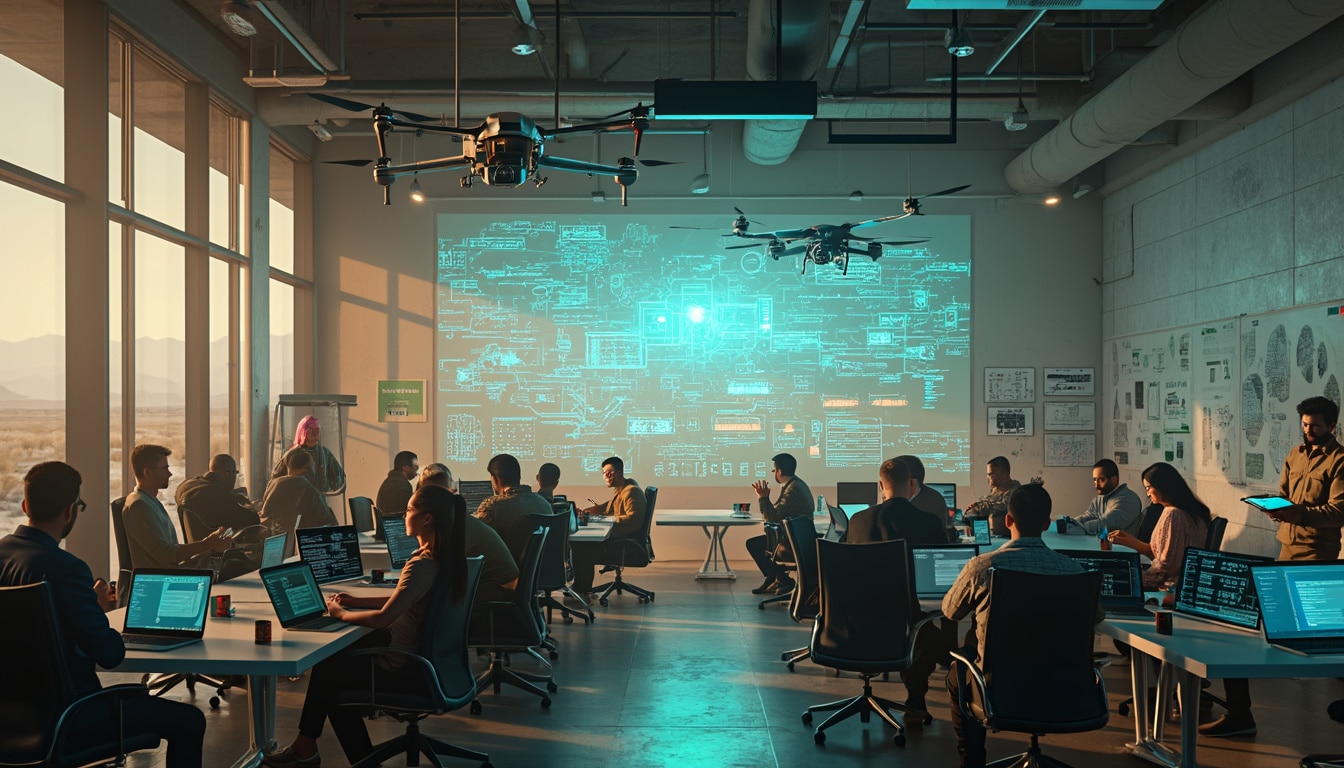In an unprecedented effort, more than a dozen selected developers have come together.Their mission? To address the challenges related to drone neutralization in the Middle Eastern region.This hackathon, named Sandtrap, highlights the commitment of the United States in the face of increasing aerial threats.
During an intensive week, these experts worked on integrated defense systems such as the Marine Air Defense Integrated System (MADIS). The prototypes developed significantly improved the speed and accuracy of countermeasures against unmanned aerial systems. With the increase in drone and missile attacks in strategic areas such as the Red Sea and the Gulf of Aden, these advancements are crucial. CENTCOM plans to organize similar events to continue strengthening air security.

Table des matières
ToggleThe Sandtrap Hackathon of Centcom: An Innovative Response to the Drone Threat in the Middle East
In an increasingly tense geopolitical context, the threat posed by drones and other unmanned aerial systems is intensifying in the Middle East. To counter this trend, Centcom initiated the Sandtrap hackathon, an ambitious initiative aimed at enhancing air security through innovative technological solutions. This event brings together coding and cybersecurity experts to develop cutting-edge tools capable of effectively detecting and neutralizing aerial threats.
What are the objectives of the Centcom Sandtrap Hackathon?
The Sandtrap hackathon was designed to address specific challenges related to drone security in the Central Command Middle East (CENTCOM) region, encompassing sensitive areas such as Afghanistan, Iran, Iraq, Syria, and Yemen. The main objective of this event is to develop prototypes that enhance the speed and accuracy of countermeasures for unmanned aerial systems. More specifically, the goal is to create solutions capable of detection, classification, tracking, and targeting hostile drones effectively.
Furthermore, Centcom aims to use this hackathon to foster technological innovation by gathering developers, data scientists, and software engineers from the United States Department of Defense. This collaborative approach allows tapping into a vast reservoir of skills and creativity, essential for responding to the dynamic and evolving threats in the region.
How does the Sandtrap Hackathon unfold, and which technologies are highlighted?
The Sandtrap hackathon spans an intensive week during which participants focus on specific challenges related to radar detection and integrated defense systems such as the MADIS (Marine Air Defense Integrated System). This platform allows for the centralized and efficient coordination of detection and interception efforts against airborne threats.
The selected teams are confronted with complex problems, requiring advanced expertise in data analysis and software development. They work on projects aimed at enhancing the capabilities of traceability and rapid response against drone attacks, which have recently increased in strategic areas such as the Red Sea and the Gulf of Aden.
What results have been achieved during the Sandtrap Hackathon?
The efforts deployed during the Sandtrap hackathon have led to the creation of innovative prototypes that enhance Centcom’s capability to counter drone threats. The developed solutions significantly improve the speed and accuracy of countermeasures, thereby allowing for a more effective reaction to potential attacks.
The Command Center emphasized the importance of these results by stating that the developed prototypes provide creative and replicable solutions for future air defense operations. These technological advancements are essential for maintaining military superiority in a region where threats are constantly evolving.
Moreover, Sandtrap has highlighted the crucial role of interdisciplinary collaboration, bringing together experts in cybersecurity, artificial intelligence, and software engineering. This synergy enables the development of robust and versatile solutions capable of adapting to the various configurations and tactics employed by drone operators.
What is the impact of Sandtrap on Centcom’s defense strategy?
The Sandtrap hackathon is part of a broader strategy for modernization and strengthening the defense capabilities of Centcom. In the face of increasing drone attacks, it is essential to have adaptive and responsive defense systems. Sandtrap contributes to this goal by integrating AI-based solutions and real-time decision-making.
By focusing on concrete challenges and mobilizing talents from the Department of Defense, Centcom can proactively anticipate and respond to emerging threats. This proactive approach is reinforced by the ongoing commitment to organize similar events, thus maintaining a constant flow of innovation and technological improvements.
What are the next steps for Centcom after Sandtrap?
Following the success of Sandtrap, Centcom plans to continue hosting similar hackathons to stay ahead of airborne threats. These events are essential to revitalize defense strategies and to integrate emerging technologies into daily military operations.
Additionally, Centcom intends to collaborate with other strategic partners, including private sector companies and academic institutions, to broaden the range of developed solutions. This collaborative approach not only diversifies the available skill sets but also encourages a culture of continuous innovation within the armed forces.
Simultaneously, Centcom strives to enhance its capabilities in advanced detection technology and automated response, integrating sophisticated radar detection systems and artificial intelligence algorithms for better real-time data interpretation.
How does Sandtrap contribute to the training of military drone experts?
The Sandtrap hackathon also plays a crucial role in the education and development of military drone experts. By bringing together professionals from diverse backgrounds, the event fosters knowledge sharing and the development of specialized skills in managing and neutralizing combat drones.
Participants in the hackathon gain valuable hands-on experience by working on real-world challenges, preparing them to respond effectively in crisis situations. Additionally, teams benefit from high-level mentoring, including experts in cybersecurity and defense technologies, which enriches their understanding of air defense mechanisms and rapid response strategies.
For those aspiring to become military drone experts, additional resources are available. For example, specific training and career paths are offered, as detailed in this article on how to become a military drone expert.
What are the future challenges for drone security in the Middle East?
The rise of drone technologies in the Middle Eastern region presents numerous challenges for regional and international security. One of the main obstacles is the need to develop defense systems capable of quickly adapting to the new tactics and technologies used by drone operators.
Another major challenge lies in the integration of advanced technological solutions, such as radar detection systems, within existing infrastructures. This requires not only significant financial investments but also close coordination among the different branches of the armed forces and their technological partners.
Moreover, the capture and reverse engineering of drone technologies by state or non-state actors presents an additional threat, further emphasizing the need for effective countermeasures.
How do submarine technologies enhanced by Swedish armed forces influence air security?
While the Sandtrap hackathon focuses on air security, other initiatives, such as enhancing submarine technology expertise by the Swedish armed forces for 2024, play a complementary role in the overall protection of strategic infrastructures. Advances in underwater technology can help improve the detection and neutralization of multi-domain threats, including drones.
These technological developments promote an integrated defense approach, where aerial and underwater systems work in synergy to provide holistic protection against diversified threats. By combining advanced capabilities across different technological domains, the armed forces can better anticipate and counter coordinated attacks, thereby enhancing the resilience of sensitive installations.
To learn more about the enhancement of underwater technology expertise, check out this article.
What role do radar detection systems play in modern security?
Radar detection systems play a crucial role in modern security by enabling precise monitoring and detection of aerial threats. These technologies are essential for identifying, tracking, and analyzing the movements of drones and other unidentified aircraft, thus providing a solid foundation for rapid and effective countermeasures.
Recent advancements in radar technologies, as described in this detailed article, highlight the importance of these systems in maintaining air superiority and ensuring the safety of sensitive installations. By combining radar detection capabilities with the innovations that emerge from the Sandtrap hackathon, Centcom strengthens its ability to proactively respond to emerging threats.
Furthermore, integrating radar data with artificial intelligence systems allows for improved precision and speed of responses, thereby reducing the time needed to neutralize a threat before it can cause significant damage. This synergy between radar technology and the advanced software solutions developed during Sandtrap is a key element of modern defense strategy.
How does Sandtrap influence future air defense?
The success of Sandtrap positions Centcom as an innovative leader in the field of air defense. By investing in hackathons and promoting collaboration among various technological experts, Centcom ensures it remains at the forefront of advances in drone security. This proactive approach not only enables the development of immediate solutions but also prepares the armed forces to face future challenges.
The impact of Sandtrap extends beyond the simple prototypes developed during the event. It creates an ecosystem where innovation can thrive continuously, with feedback and constant iterations to refine and improve defense systems. This translates into an increased capability to anticipate threats and react swiftly, thereby ensuring the security of military operations in complex and dynamic environments.
Finally, Sandtrap inspires other branches of the armed forces and organizations to adopt similar approaches to solve complex problems. By disseminating the successes and lessons learned during this hackathon, Centcom fosters a culture of innovation and collaboration that is essential to address the multifaceted challenges of modern security.























